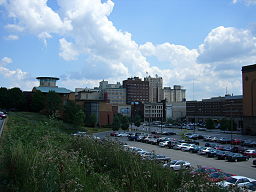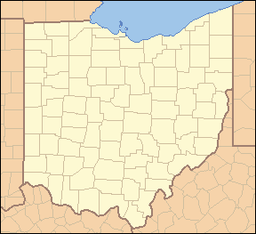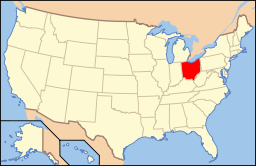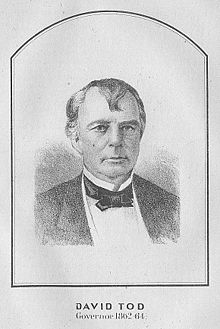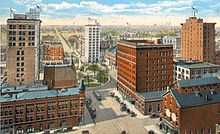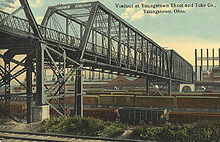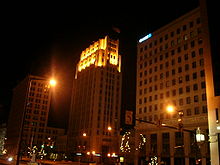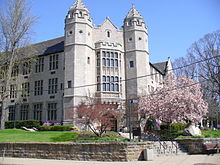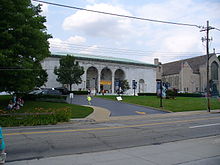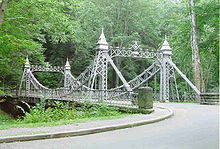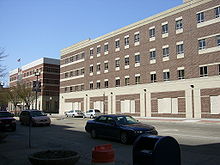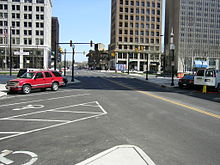- Youngstown, Ohio
-
"Youngstown" redirects here. For other uses, see Youngstown (disambiguation).
City of Youngstown City Skyline of downtown YoungstownSealOfficial name: City of Youngstown Named for: John Young Country United States State Ohio Counties Mahoning County, Trumbull County Elevation 850 ft (259 m) Coordinates 41°5′47″N 80°38′57″W / 41.09639°N 80.64917°W Area 34.2 sq mi (89 km2) - land 33.9 sq mi (88 km2) - water 0.3 sq mi (1 km2) Population 66,982 (2010) - urban 565,773 [1] - metro 763,207 [2] Density 2,312.9 / sq mi (893 / km2) Founded 1796 - Incorporated (village) 1848 - Incorporated (city) 1867 Timezone EST (UTC-5) - summer (DST) EDT (UTC-4) Zip code 44501–44507, 44509-44515, 44555 Area code 330 FIPS code 39-88000 [3] GNIS feature ID 1058156 [4] Website: http://www.cityofyoungstownoh.org Youngstown is a city in the U.S. state of Ohio and the county seat of Mahoning County;[5] it also extends into Trumbull County.[6] The municipality is situated on the Mahoning River, approximately 65 miles (105 km) southeast of Cleveland and 61 miles (100 km) northwest of Pittsburgh, Pennsylvania. Youngstown has its own metropolitan area, but is often included in commercial and cultural depictions of the Pittsburgh Tri-State area and Greater Cleveland.[7] Youngstown lies 10 miles (16 km) west of the Pennsylvania state line, midway between New York City and Chicago via Interstate 80.
The city was named for John Young, an early settler from Whitestown, New York, who established the community's first sawmill and gristmill.[8] Youngstown is located in a region of the United States that is often referred to as the Rust Belt. Traditionally known as a center of steel production, Youngstown was forced to redefine itself when the U.S. steel industry fell into decline in the 1970s, leaving communities throughout the region without major industry.[9] The 2010 census showed that Youngstown had a total population of 66,982,[10] making it Ohio's ninth largest city.
According to the 2010 Census, the Youngstown-Warren-Boardman Metropolitan Statistical Area (MSA) contains 565,773 people and includes Mahoning and Trumbull counties in Ohio, and Mercer County in Pennsylvania.[10] The Steel Valley area as a whole has 763,207 residents.[11]
Contents
Origins
Youngstown was named for New York native John Young, who surveyed the area in 1796 and settled there soon after.[12] On February 9, 1797, Young purchased the township of 15,560 acres (63 km²) from the Western Reserve Land Company for $16,085.[13] The 1797 establishment of Youngstown was officially recorded on August 19, 1802.[14]
The area constituting present-day Youngstown was part of the Connecticut Western Reserve, a section of the Northwest Territory reserved for settlers from the state of Connecticut.[15] While many of the area's early settlers came from Connecticut, Youngstown attracted a significant number of Scots-Irish settlers from neighboring Pennsylvania.[16] The first European Americans to settle permanently in the area were Pittsburgh native James Hillman and wife Catherine Dougherty.[17] By 1798, Youngstown was the home of several families who were concentrated near the point where Mill Creek meets the Mahoning River.[15]
As the Western Reserve's population grew, the need for administrative districts became apparent. In 1800, territorial governor Arthur St. Clair established Trumbull County (named in honor of Connecticut Governor Jonathan Trumbull), and designated the smaller settlement of Warren as its administrative center, or "county seat".[18] In 1813, Trumbull County was divided into townships, with Youngstown Township comprising much of what became Mahoning County.[19] The village of Youngstown was incorporated in 1848, and in 1867 Youngstown was chartered as a city. It became the county seat in 1876, when the administrative center of Mahoning County was moved from neighboring Canfield.[20]
The discovery of coal by the community in the early 19th century paved the way for the Youngstown area's inclusion on the network of the famed Erie Canal. The Pennsylvania and Ohio Canal Company was organized in 1835, and the canal was completed in 1840.[21] Local industrialist David Tod, who was later Ohio governor during the Civil War, persuaded Lake Erie steamboat owners that coal mined in the Mahoning Valley could fuel their vessels if canal transportation were available between Youngstown and Cleveland. The arrival of the railroad in 1856 smoothed the path for further economic growth.[22]
Peopling of the valley
Youngstown's industrial development changed the face of the Mahoning Valley. The community's burgeoning coal industry drew hundreds of immigrants from Wales, Germany, and Ireland. With the establishment of steel mills in the late 19th century, Youngstown became a popular destination for immigrants from Eastern Europe, Italy, and Greece.[23] In the early 20th century, the community saw an influx of immigrants from non-European countries including what is modern day Lebanon, Israel, and Syria. By the 1920s, this dramatic demographic shift produced a nativist backlash, and the Mahoning Valley became a center of Ku Klux Klan activity.[24] The situation reached a climax in 1924, when street clashes between Klan members and Italian and Irish Americans in neighboring Niles led Ohio Governor A. Victor Donahey to declare martial law.[25] By 1928, however, the Klan was in steep decline; and three years later, the organization sold its Canfield, Ohio, meeting area, Kountry Klub Field.[26] Today, the metropolitan area's ethnic diversity is reflected in businesses such as a Jewish delicatessen, Italian eateries, and Middle Eastern restaurants. Urban neighborhoods are dotted with churches, synagogues, and mosques.
The growth of industry attracted people from within the borders of the United States, and from Latin America. By the late 19th Century, African Americans were well represented in Youngstown, and the first local congregation of the African Methodist Episcopal Church was established in 1871.[27] In the 1880s, local attorney William R. Stewart was the second African American elected to the Ohio House of Representatives.[28] A large influx of African Americans in the early 20th century owed much to developments in the industrial sector. During the national Steel Strike of 1919, local industrialists recruited thousands of workers from the South, many of whom were Black.[29] This move inflamed racist sentiment among local Whites, and for decades, African-American steelworkers experienced discrimination in the workplace.[30][31] Migration from the South rose dramatically in the 1940s, when the mechanization of southern agriculture brought an end to the exploitative sharecropping system, leading onetime farm laborers to seek industrial jobs.[32]
The city's population became more diverse since the end of World War II, when a seemingly robust steel industry attracted thousands of workers.[33] In the 1950s, the Latino population grew significantly; and by the 1970s, St. Rose of Lima Roman Catholic Church and the First Spanish Baptist Church of Ohio were among the largest religious institutions for Spanish-speaking residents in the Youngstown metropolitan area.[27] While diversity is among the community's enduring characteristics, the industrial economy that drew various groups to the area collapsed in the late 1970s. In response to subsequent challenges, the city has taken well-publicized steps to diversify economically, while building on some traditional strengths.[34]
Geography and climate
Youngstown is located at 41°5′47″N 80°38′57″W / 41.09639°N 80.64917°W (41.096258, −80.649299).[35] It borders or touches the following other townships and municipalities:
- Boardman Township, Mahoning County on the south
- Canfield Township, Mahoning County on the southwest
- Austintown Township, Mahoning County on the west
- Weathersfield Township, Trumbull County, on the northwest (touches, but does not border)
- Girard, Trumbull County on the north–northwest
- Liberty Township, Trumbull County, on the north
- Hubbard Township, Trumbull County, on the northeast
- Coitsville Township, Mahoning County on the east
- Campbell, Mahoning County on the east–southeast
- Struthers, Mahoning County on the southeast
- Poland, Ohio, Mahoning County on the south-southeast
According to the United States Census Bureau, the city has a total area of 34.2 square miles (88.7 km²); 33.9 square miles (87.8 km²) is land and 0.3 square mile (0.9 km²) is water. The total area is 1.02% water.
Youngstown is in the Mahoning Valley on the Glaciated Allegheny Plateau. At the end of the last Ice Age, the glaciers left behind a uniform plain with valleys caused by the Mahoning River crossing the plain.[36] Lakes created by glaciers that dammed small streams were eventually drained, leaving behind fertile terrain.[36]
Climate data for Youngstown, Ohio Month Jan Feb Mar Apr May Jun Jul Aug Sep Oct Nov Dec Year Record high °F (°C) 71
(22)73
(23)82
(28)90
(32)95
(35)99
(37)103
(39)100
(38)99
(37)88
(31)80
(27)76
(24)103
(39)Average high °F (°C) 32.1
(0.1)35.7
(2.1)46.2
(7.9)58.2
(14.6)69.3
(20.7)77.6
(25.3)81.7
(27.6)80.0
(26.7)72.5
(22.5)60.9
(16.1)48.3
(9.1)37.1
(2.8)58.3 Average low °F (°C) 17.8
(−7.9)19.8
(−6.8)27.6
(−2.4)36.0
(2.2)46.7
(8.2)55.2
(12.9)59.4
(15.2)58.1
(14.5)51.4
(10.8)41.3
(5.2)33.4
(0.8)23.8
(−4.6)39.3 Record low °F (°C) −22
(−30)−16
(−27)−10
(−23)11
(−12)24
(−4)30
(−1)40
(4)32
(0)27
(−3)20
(−7)1
(−17)−12
(−24)−22
(−30)Precipitation inches (mm) 2.34
(59.4)2.03
(51.6)3.05
(77.5)3.33
(84.6)3.45
(87.6)3.95
(100.3)4.14
(105.2)3.42
(86.9)3.93
(99.8)2.47
(62.7)3.06
(77.7)3.00
(76.2)38.15
(969)Snowfall inches (cm) 13.8
(35.1)9.9
(25.1)9.9
(25.1)2.2
(5.6)0
(0)0
(0)0
(0)0
(0)0
(0).6
(1.5)4.4
(11.2)11.9
(30.2)52.8
(134.1)Avg. precipitation days (≥ 0.01 in) 16.1 13.5 14.4 14.3 12.9 12.0 10.4 10.2 11.4 11.1 14.6 16.5 157.4 Avg. snowy days (≥ 0.1 in) 12.7 9.3 6.8 2.6 0 0 0 0 0 .6 4.8 10.3 47.2 Source: National Weather Service[37] Demographics
Historical populations Census Pop. %± 1850 2,802 — 1860 2,759 −1.5% 1870 8,075 192.7% 1880 15,435 91.1% 1890 33,220 115.2% 1900 44,885 35.1% 1910 79,066 76.2% 1920 132,358 67.4% 1930 170,002 28.4% 1940 167,720 −1.3% 1950 168,330 0.4% 1960 166,688 −1.0% 1970 139,788 −16.1% 1980 115,427 −17.4% 1990 95,787 −17.0% 2000 82,026 −14.4% 2010 66,982 −18.3% According to the 2000 Census numbers, Youngstown has 32,177 households and 19,724 families in the city. The population density is 893/km² (2,312.9/sq mi). There are 37,159 housing units at an average density of 1,096.3 per square mile (423.2/km²).[38]
The racial makeup of the city is roughly 43% White, 45% Black or African American, and 9% Hispanic or Latino of any race, though Puerto Ricans are the dominant Latino group.[38][39]
Records suggest that 27.2% of the households have children under the age of 18. Of these, 33.2% are married couples living together, 22.9% have a female householder with no husband present, and 38.7% are non-families. Meanwhile, 34.0% of all households comprise a single person, and 14.7% of households comprise a person over 65 years of age living alone. The average household size is 2.39 and the average family size is 3.07.[38]
In Youngstown, the population leans toward greater numbers of youths, as is often the case in U.S. inner-city areas with higher birth rates. Survey data show the following: 25.8% under the age of 18, 10.1% from 18 to 24, 26.4% from 25 to 44, 20.3% from 45 to 64, and 17.4% who are 65 years of age or older. The median age is 36 years. For every 100 females, there are 91.9 males; for every 100 females aged 18 and over, there are 87.8 males.[38]
The median household income is $24,201, and the median family income $30,701; but the average per capita income for the city is $13,293. Males have a median income of $29,900 and females $21,050. About 24.8% of the population lives below the poverty line. Out of the total population, 37.3% of those under the age of 18 and 13.3% of those 65 and older are living below the poverty line.[38]
The United States Census Bureau's 2006 Annual Social and Economic (ASEC) Supplement Current Population Survey estimates a median household income of $21,850. Analysis by CNNMoney states that Youngstown has the lowest median income of U.S. cities with more than 65,000 residents.[40]
Economy
Endowed with large deposits of coal and iron as well as "old growth" hardwood forests needed to produce charcoal, the Youngstown area eventually developed a thriving steel industry. The area's first blast furnace was established to the east of town in 1803 by James and Daniel Heaton.[41] In time, the availability of fossil fuels contributed to the development of other coal-fired mills, including the Youngstown Rolling Mill Company, which was established in 1846.[42] By the mid-19th century, Youngstown was the site of several iron industrial plants, notably David Tod's Brier Hill Iron & Coal Company.[43] The iron industry continued to expand in the 1890s, despite the depletion of local natural resources. Numerous rail connections ensured a consistent supply of coal and iron ore from neighboring states.[44]
At the turn of the 20th century, local industrialists began to convert to steel manufacturing, amid a wave of industrial consolidations that placed much of the Mahoning Valley's industry in the hands of national corporations.[45] Shortly after the establishment of U.S. Steel in 1901, the corporate entity absorbed Youngstown's premier steel producer, the National Steel Company.[45] One year earlier, however, a group of city investors took steps to ensure high levels of local ownership in the area's industrial sector. Led by local industrialists George D. Wick and James A. Campbell, they organized what became the Youngstown Sheet and Tube Company,[45] among the nation's most important regional steel producers.[46] The firm significantly expanded its operations in 1923, when it acquired plants in South Chicago and East Chicago, Indiana. This impulse to support local ownership surfaced again in 1931, when Campbell, as chairman of the Youngstown Sheet and Tube Company, attempted to merge the firm with Bethlehem Steel, in a bid to create the nation's second-largest steel corporation.[47] Other area industrialists blocked the move,[48][49] with the financial backing of Republic Steel founder Cyrus S. Eaton, who feared the implications of a strengthened Bethlehem Steel.[50]
In the late 1930s, the community's steel sector gained national attention once again, when Youngstown became a site of the so-called "Little Steel Strike", an effort by the Steel Workers Organizing Committee, a precursor to United Steelworkers, to secure contract agreements with smaller steel companies.[51] These firms included Republic Steel, Bethlehem Steel, Youngstown Sheet and Tube, National Steel, Inland Steel, and American Rolling Mills.[51] Gus Hall, one of the committee's founding organizers, led strikes in Youngstown and Warren.[51] On June 21, 1937, strike-related violence in Youngstown resulted in two deaths and 42 injuries.[51] Despite violent episodes in Youngstown and Chicago, the Little Steel Strike proved to be a turning point in the history of the U.S. labor movement. Historian William Lawson observed that the strike transformed industrial unions from "basically local and ineffective organizations into all-encompassing, nationwide collective bargaining representatives of American workers".[51] A historical marker commemorating the strike was recently installed on the grounds of the Youngstown Historical Center of Industry and Labor.[51][52]
Decline of steel
For more details on this topic, see Deindustrialization of Youngstown, Ohio.Between the 1920s and 1960s, the city was known as an important industrial hub that featured the massive furnaces and foundries of such companies as Republic Steel and U.S. Steel. At the same time, Youngstown never became economically diversified, as did larger industrial cities such as Chicago, Pittsburgh, Akron, or Cleveland.[46] Hence, when economic changes forced the closure of plants throughout the 1970s, the city was left with few substantial economic alternatives. The 1969 corporate merger between the Youngstown Sheet and Tube Company and the New Orleans-based Lykes Corporation proved to be a turning point in the demise of the local steel industry.[53] The merger and subsequent takeover of Youngstown Sheet and Tube burdened the community's primary steel producer with hundreds of thousands of dollars in debt.[53] Further, the deal placed control of the company outside of the Mahoning Valley.[53] The September 19, 1977, announcement of the closure of a large portion of Youngstown Sheet and Tube, an event still remembered by many Youngstowners as "Black Monday", is widely regarded as the death knell of the old area steel industry. This was followed by the withdrawal of U.S. Steel in 1979 and 1980, and the bankruptcy of Republic Steel in the mid-1980s.[54] Attempts to revive the local steel industry proved unsuccessful. Shortly after the closure of most of Youngstown Sheet and Tube's area operations, local religious leaders, steelworkers, and activists such as Staughton Lynd participated in a grassroots effort to purchase and refurbish one of the company's abandoned plants in neighboring Campbell, Ohio.[55] This project met with failure in April 1979.[55] In the wake of the steel plant shutdowns, the community lost an estimated 40,000 manufacturing jobs, 400 satellite businesses, $414 million in personal income, and from 33 to 75 percent of the school tax revenues.[56] The Youngstown area has yet to fully recover from the loss of jobs in the steel sector.[57]
Post-steel economy
Youngstown is the site of several steel and metalworking operations, though nothing on the scale seen during the "glory days" of the "Steel Valley". The largest employer in the city is Youngstown State University (YSU), an urban public campus that serves about 15,000 students, located just north of downtown.[58]
The blow dealt to the community's industrial economy in the 1970s, was slightly mitigated by the presence of auto production plants in the metropolitan area. In the late 1980s, the Avanti, an automobile with a fiberglass body originally designed by Studebaker to compete with the Corvette, was manufactured in an industrial complex located on Youngstown's Albert Street. However, this company didn't last long in Youngstown, moving after just a few years.[59] A mainstay, though, of Youngstown's industrial economy has long been the GM Lordstown plant.The General Motors' Lordstown Assembly plant is the largest industrial employer in the area.[60] One of the nation's largest auto plants in terms of square feet, the Lordstown facility was home to production of the Chevrolet Impala, Vega, and Cavalier. Recently expanded and retooled with a new paint facility, it is the current home of the Cavalier's successor, the 2011 Chevrolet Cruze.[60]
The largest industrial employers within the Youngstown city limits are V&M Star Steel Company (formerly North Star Steel), in the Brier Hill district, and Exal Corporation, located on Poland Avenue. The latter has recently expanded its operations.[61]
New growth
Youngstown's downtown, which once underscored the community's economic difficulties, is a site of new business growth. The Youngstown Business Incubator, located in the heart of the downtown, houses several start-up technology companies, which have received office space, furnishings, and access to utilities.[62] Some companies supported by the incubator have earned recognition, and a few are starting to outgrow their current space. One such company–Turning Technologies–has been rated by Inc. Magazine as the fastest-growing privately held software company in the United States and 18th fastest-growing privately held company overall.[63] In an effort to keep such companies downtown, the incubator secured approval to demolish a row of vacant buildings nearby to clear space for expansion. The project will be funded by a $2 million federal grant awarded in 2006.[62]
Businesses started in Youngstown area
Extensive coverage of Youngstown's economic challenges has overshadowed the city's long entrepreneurial tradition. A number of products and enterprises introduced in Youngstown later became national household names. Among these is Youngstown-based Schwebel's Bakery, which was established in neighboring Campbell in the 20th century. The company now distributes bread products nationally.[64] In the 1920s, Youngstown was the birthplace of the Good Humor brand of ice cream novelties,[65] and the popular franchise of Handel's Homemade Ice Cream & Yogurt was established there in the 1940s. In the 1950s, the suburb of Boardman became the site of one of the country's first modern shopping plazas, which was established by Youngstown-born developer Edward J. DeBartolo, Sr.[66] The fast-food chain, Arby's, opened the first of its restaurants in Boardman in 1964, and Arthur Treacher's Fish & Chips was headquartered in Youngstown in the late 1970s. More recently, the city's downtown hosted the corporate headquarters of the now-defunct pharmacy chain store Phar-Mor, which was established by Youngstown native Mickey Monus.[67]
Post-steel image in popular culture
A large segment of the American public associates Youngstown with the economic malaise that befell much of the industrial northeast after the collapse of its manufacturing sector. The decline of Youngstown's steel industry and its adverse effects on local workers were the subjects of Bruce Springsteen's ballad, "Youngstown", featured on his The Ghost of Tom Joad album.[68] In the lyric, Springsteen addresses "my sweet Jenny," a reference to the Jeanette Blast Furnace, owned by Youngstown Sheet and Tube Company, which sat along the Mahoning River in the Brier Hill area of the city and was dynamited in 1977. Springsteen made Youngstown the first stop on his solo Ghost of Tom Joad Tour, playing to a sold-out audience at Stambaugh Auditorium on January 12, 1996.
Another pop culture reference to Youngstown came via the HBO television show The Sopranos in 2002. In the show's fourth season premiere episode, entitled "For All Debts Public and Private", the character Paulie Gualtieri is imprisoned in Youngstown for possessing a weapon that was used in an unsolved Youngstown murder. This episode's use of Youngstown as a setting seems to reference the city's association with crime and mob-related violence.
Rebirth of Steel
In 2010, Vallourec and Mannesman Tubes broke ground for a $620 million-dollar pipe mill north of it's existing business V&M Star. The facility is 1 million square feet in area and will produce tube goods to service natural gas exploration in the Marcellus Formation, which is the largest gas field discovered in the past decade, estimated to provide enough natural gas to supply the United States for 100 years. Production is expected to begin in 2012.
Government
Youngstown is governed by a mayor who is elected every four years and limited to a maximum of two terms. Mayors are traditionally inaugurated on or around the second of January. The city has tended to elect Democratic mayors since the late 1920s because of the local unions' support for Democratic candidates for office.[69] Youngstown's current mayor is Charles Sammarone, who replaced Jay Williams, the city's first African-American mayor and its first independent mayor since 1922.[70] Williams belonged to the Mayors Against Illegal Guns Coalition,[71] a bi-partisan group with the stated goal of "making the public safer by getting illegal guns off the streets".[71] He left his position in Youngstown to become President Barack Obama's auto czar, directing the Presidential Task Force on the Auto Industry.
Residents elect an eight-member city council, which includes representatives of the city's seven wards and a council president. The council, in turn, appoints a city clerk. The council traditionally meets every first and third Wednesday of the month. City council meetings are generally held from the third week in September to the third week in June. Meanwhile, the board of control oversees contracts for public projects within the municipal limits. The Youngstown Police Department and Youngstown Fire Department fall under the board's supervision, as do the parks, civil service, community development, health, planning, and water departments.
Youngstown's finance department oversees all municipal finances and supervises the departments of economic development and income tax. The city's department of public works has sweeping supervisory responsibilities and oversees the departments of engineering, building inspection, building and grounds, signal and sign, demolition and housing, litter and recycling, street, and water waste treatment. The city's law department represents the city on all legal issues, serving as counsel to all municipal departments.
Education
Public
The Youngstown City School District manages all public education within the city. As of 2007, the school district was engaged in a process of reconfiguration, consolidating existing schools while building some new ones. District high schools once included South, North, Chaney, Rayen, East, Woodrow Wilson, Youngstown Early College, and Choffin Career and Technical Center. This roster has changed, however. Chaney expanded, while Rayen and Wilson were closed to make way for a newly built East High School.[72] Youngstown City School District participate in an "Early College" program, in cooperation with Youngstown State University. This program enables high school students to attend classes on campus and earn college credit.[73]
Private
The Diocese of Youngstown once oversaw more than 20 schools within the city limits. As a result of dwindling enrollment, however, only three Catholic schools continue to operate within Youngstown proper.[74] These include one elementary school – St. Christine's – and two secondary schools, Ursuline and Cardinal Mooney. (The two high schools share a heated and longstanding rivalry in athletics.) Several additional Catholic schools operate in Mahoning, Trumbull, Columbiana, Portage, Stark, and Ashtabula counties.
There is also Akiva Academy on Gypsy Lane in Youngstown.
Youngstown hosts a small number of charter schools and one Montessori school. The Montessori School of the Mahoning Valley, which recently celebrated its 35th year, offers alternative learning environments for students ranging from preschool to eighth grade.[75]
Higher education
Youngstown State University, the primary institution of higher learning in the Youngstown-Warren metropolitan area, traces its origins to a local YMCA program that began offering college-level courses in 1908.[76] YSU joined the Ohio system of higher education in 1967.[76] Once regarded as a commuter school, YSU serves about 13,000 students, many from outside the Youngstown area. The campus is situated just north of the city's downtown and south of Youngstown's historic district, a neighborhood of Tudor-, Victorian-, and Spanish Colonial Revival-style homes.[77]
YSU offers the lowest tuition of any public institution of higher learning in Ohio, and its campus was reported to be among the safest in the state in 1996.[78][dated info] The university's assets include the Dana School of Music, an All-Steinway school. The Dana School of Music is one of the six oldest continuously operating schools of music in the United States. Youngstown State's Engineering programs are accredited through ABET, making it one of the best Engineering Schools in the country, many graduates from the school have gone on to become the founders and heads for various Fortune 100 companies. [79]
Attractions
Covelli Centre
Main article: Covelli CentreDespite the impact of regional economic decline, Youngstown offers an array of cultural and recreational resources. Moreover, the community's range of attractions has increased in recent years. The newest addition is the Covelli Centre, a venue for Tier I Jr. A hockey games, concerts, "on ice" shows, and other forms of entertainment.
Theater
The community's culture center is Powers Auditorium, a former Warner Brothers movie palace[80] that serves as the area's primary music hall while providing a home for the Youngstown Symphony Orchestra.[81] This downtown landmark is one of five auditoriums located within the city limits. Ford Recital Hall was built in 2006 as an addition to newly renovated Powers Auditorium. Imposing and neo-classical Stambaugh Auditorium, located on the city's north side, has served for decades as a site of concerts and is often rented for private events. The facility also hosts the Stambaugh Youth Concert Band.[82]
Oakland Center for the Arts, located in the downtown area, is a venue for locally produced plays. This institution is complemented by the Youngstown Playhouse, which is located on the city's south side. The Youngstown Playhouse, Mahoning County's primary community theater, has served the area for more than 80 years, despite intermittent financial problems. Well known theatrical personalities from the Youngstown area include comedic actor Joe Flynn,[83] screen actress Elizabeth Hartman,[84] singer and Broadway performer Maureen McGovern,[85] and television and screen actor Ed O'Neill.[86]
Museums
The Butler Institute of American Art is located on the northeastern edge of the Youngstown State University campus. This institution was established by industrialist Joseph G. Butler, Jr., in 1919 as the first museum in the country dedicated to American art.[87] Across the street from the Butler Institute stands the McDonough Museum of Art, YSU's University Art Museum and the Mahoning Valley's center for contemporary art. The McDonough, established in 1991, features regular changing exhibitions by regional, national and international artists and provides public access to the work of students, faculty and alumni from the Department of Art.[88] The Clarence R. Smith Mineral Museum, also located on the YSU campus, is operated by the university's geology department and housed in a campus building.[89]
To the immediate north of YSU is the Arms Family Museum of Local History. The museum, housed in a 1905 Arts & Crafts style mansion on the main artery of Wick Avenue, is managed by the Mahoning Valley Historical Society. Once the estate of a local industrialist, the museum maintains period rooms that showcase the original contents of the household, including furnishings, art objects, and personal artifacts. The museum mounts rotating exhibits on topics related to local history. Recently, the museum opened the "Anne Kilcawley Christman Hands-on History Room". The MVHS Archival Library operates in the estate's former carriage house, located near the back of the site.
Located just south of the YSU campus is the Youngstown Historical Center of Industry and Labor, which sits on a grade overlooking the downtown area. This museum, owned and operated by the Ohio Historical Society, focuses on the Mahoning Valley's history of steel production.[90] Other museums include the Children's Museum of the Valley,[91] an interactive educational center located in the downtown area, and the Davis Education and Recreation Center, a small museum that showcases the history of Youngstown's Mill Creek Park.[92] On the city's north side the Youngstown Steel Heritage Foundation is constructing the Tod Engine Heritage Park, featuring a collection of steel industry equipment and artifacts. The main exhibit is a 1914 William Tod Co. rolling mill steam engine that was built in Youngstown and used at the Youngstown Sheet and Tube Brier Hill Works. The Tod Engine is one of three remaining rolling mill engines in the United States and is a Mechanical and Materials Engineering Landmark.[93]
Parks
Youngstown's most popular resource is Mill Creek Park, a five-mile (8 km)-long stretch of landscaped woodland reminiscent of Rock Creek Park in Washington, D.C. Mill Creek Park is the oldest park district in Ohio, established as a township park in 1891. The park's highlights include the restored 19th century Lanterman's Mill, the rock formations of Bear's Den, scores of nature trails, the Fellows Riverside Gardens and Education Center, the "Cinderella" iron link bridge, and two 18 hole Donald Ross golf courses.[94][95]
Mill Creek Park encompasses approximately 2,600 acres (11 km2), 20 miles (32 km) of drives and 15 miles (24 km) of foot trails. Its attractions include gardens, streams, lakes, woodlands, meadows, and wildlife.
Fellows Riverside Gardens' popular lookout point offers visitors contrasting views of the area. From the south side, the canopied woodlands overlooking Lake Glacier are visible; from the north side, visitors are presented with a view of downtown Youngstown. The park features two 18-hole golf courses. The North Course is situated on rolling terrain, while the South Course features narrow, tree-lined fairways.[96] Other features include playgrounds, athletic fields, and picnic areas.
In 2005, Mill Creek Park was placed on the National Register of Historic Places.[97] A plaque commemorating this event is located near a memorial statue of Volney Rogers, the Youngstown attorney who set aside land for the creation of Mill Creek Park.[92]
A smaller recreational area called Wick Park is located on the historic north side. Wick Park's periphery is lined with early 20th-century mansions built by the city's industrialists, business leaders, and professionals during Youngstown's "boom" years.[77] Stambaugh Auditorium, a popular venue for concerts and other public events, is located near the park's southwestern edge.[82] Several cemeteries (notably historic Oak Hill Cemetery) and small recreational spaces are scattered throughout the city.
Sports
Club League Venue Established Championships Youngstown Phantoms USHL, Ice hockey Covelli Centre 2003 0 Youngstown has enjoyed a long tradition of professional and semi-professional sports.[98] In earlier decades, the city produced scores of minor league baseball teams, including the Youngstown Ohio Works, Youngstown Champs, Youngstown Indians, Youngstown Steelmen, Youngstown Browns, Youngstown Gremlins, and Youngstown Athletics. Local enthusiasm for baseball was such that the community hosted championship games of the National Amateur Baseball Federation throughout the 1930s and 1940s.[99] The area's minor league baseball teams were supplemented by semi-professional football teams, including the Youngstown Patricians, which won the 1915 championship of what became the National Football League,[100] and the Youngstown Hardhats, which competed in the Middle Atlantic Football League in the 1970s and early 1980s. For three seasons, Youngstown was home to the Mahoning Valley Thunder of the now-defunct af2, the minor league for the Arena Football League until 2009 when the franchise ceased operations.[101][102] Local minor league basketball teams included the Youngstown Pride (which played in the WBA from 1987 to 1992), the Youngstown Hawks (IBA, 1999), and the Mahoning Valley Wildcats (IBL, 2005). Youngstown's Covelli Centre was the home of the Youngstown SteelHounds hockey team (when it was the Chevrolet Centre), which played in the Central Hockey League until May 2008.
In early 2007, the "Championship Wrestling Experience" began holding events in the area that featured stars like "Jake the Snake" Roberts and Jerry Lynn. These wrestlers have appeared at the "Salute to Wrestling" event held in July for the Mahoning Valley Scrappers.
The community has a lengthy tradition of collegiate sports. The Youngstown State University Penguins, a major regional draw, compete in the Missouri Valley Football Conference. The Penguins, noted participants in FCS (I-AA) football, play their games at Stambaugh Stadium and enjoy one of the more supportive fan bases. All other YSU athletic teams compete in the Horizon League. The Youngstown State men and women's basketball teams hold their games at Youngstown State's Beeghly Center. The teams average about 2,500 fans per game, a number which has been on the rise the past two seasons with a new style of play under Head Coach Jerry Slocum. In addition, the YSU baseball and softball teams have enjoyed local support and success. The baseball team reached the NCAA super-regionals in 2005, and the softball team did so in 2006.[103]
Meanwhile, Youngstown has produced a significant number of boxing champions, including bantamweight Greg Richardson, lightweights Ray "Boom Boom" Mancini, Harry Arroyo, and middleweight Kelly Pavlik.[104]
Building on tradition
One of the city's most recent sports-related attractions is the Covelli Centre (formerly the Chevrolet Center and during planning the Youngstown Convocation Center), which was funded primarily through a $26 million federal grant. Located on the site of an abandoned steel mill, the large, high-tech facility opened in October 2005.[105] The Centre's main tenants are the Youngstown Phantoms, which play in the United States Hockey League, and the Mahoning Valley Thunder, an af2 arena football team which began play in 2007. Previously, it was home to the Youngstown Steelhounds hockey team, who played in the CHL. The city plans to develop vacant land adjacent to the Centre. Plans included using the space for a park, riverwalk (the Mahoning River flows through the site), amphitheater, or athletic stadium for the city's public and private high schools.
Such investments reflect wide appreciation of Youngstown's athletic tradition, which has produced noted figures in a variety of sports. Prominent athletes with connections to the city include former world boxing champions Greg Richardson, IBF lightweight champion Harry Arroyo,[104] College Football Hall of Fame end Bob Dove,[106] Hall of Fame umpire Billy Evans,[107] major league pitcher Dave Dravecky,[108] NFL quarterback Bernie Kosar,[101] IBF cruiserweight champion Jeff Lampkin,[104] WBA lightweight champion Ray "Boom Boom" Mancini,[104] major league manager Jimmy McAleer,[109] WBC and WBO middleweight champion Kelly Pavlik,[110] legendary baseball trainer "Bonesetter" Reese,[111] major league outfielder George Shuba,[112] and Heisman Trophy recipient Frank Sinkwich.[101]
Former attractions
Several of the city's recreational resources disappeared amid the economic hardships that began in the late 1970s. Among these was Idora Park, an amusement park that served as a convenient alternative for residents who preferred not to travel to larger parks in Northern Ohio and Western Pennsylvania.[113] (These included Conneaut Lake Park in Conneaut Lake, Pennsylvania, Geauga Lake in Aurora, Ohio, Cedar Point in Sandusky, Ohio, and Kennywood in Pittsburgh.) The park, which closed in 1984, held sentimental value for many local residents and enjoyed a degree of historical significance. Former Youngstown resident Jack Warner noted in his autobiography that the Warner brothers took their first step into the movie business when they screened a used copy of The Great Train Robbery at Idora Park and other local venues.[114]
From the early 20th century to the mid-1970s, Youngstown was the retail center of the Mahoning Valley. There were two flagship department stores in the downtown area, including Strouss Hirshberg's (later absorbed by Kaufmann's, now part of Macy's) and McKelvey's (later Higbee's, now part of Dillard's). Specialty shops lined the main artery of West Federal Street, and the district had four upscale movie theaters, including the Palace Theater, the Warner Brothers' first Theater, the State Theater, and the Paramount Theater. These businesses were the first to close as a result of declining attendance in the 1950s, 1960s, and 1970s.
In the early 1970s, the appearance of two suburban malls (the Southern Park Mall, in Boardman, and the Eastwood Mall, in Niles) hastened the closure or relocation of many businesses that remained. The collapse of the community's steel industry at the end of the decade created additional challenges for downtown business owners; and throughout the 1980s and 1990s, efforts to revive the former retail hub were unsuccessful.[115]
Redevelopment
Youngstown's cityscape includes relatively few contemporary buildings, and from certain angles, the downtown area appears to have changed little since the 1960s. Yet, downtown Youngstown has seen modest levels of new construction. Recent additions include the George Voinovich Government Center and state and federal courthouses: the Seventh District Court of Appeals and the Nathaniel R. Jones Federal Building and U.S. Courthouse. The latter features an award-winning design by the architectural firm, Robert A. M. Stern Architects.[116]
In 2005, Federal Street, a major downtown thoroughfare that was closed off to create a pedestrian-oriented plaza, was reopened to through traffic. The downtown area has seen the razing of structurally unsound buildings and the expansion or restoration of others.[117]
Construction and business development
In 2004, construction began on a 60-home upscale development called Arlington Heights, and a grant from the United States Department of Housing and Urban Development allowed for the demolition of Westlake Terrace, a sprawling and dilapidated public housing project. Today, the site features a blend of senior housing, rental townhouses and for-sale single-family homes. Low real-estate prices and the efforts of the Youngstown Central Area Improvement Corporation (CIC) have contributed to the purchase of several long-abandoned downtown buildings (many by out-of-town investors) and their restoration and conversion into specialty shops, restaurants, and eventually condominiums. Further, a nonprofit organization called Wick Neighbors is planning a $250 million New Urbanist revitalization of Smoky Hollow, a former ethnic neighborhood that borders the downtown and university campus. The neighborhood will eventually comprise about 400 residential units, university student housing, retail space, and a central park.[118] Construction for the project began in 2006.
New construction has dovetailed with efforts to cultivate business growth. One of the area's more successful business ventures in recent years has been the Youngstown Business Incubator. This nonprofit organization, based in a former downtown department store building, fosters the growth of fledgling technology-based companies. The incubator, which boasts more than a dozen business tenants, has recently completed construction on the Taft Technology Center, where some of its largest tenants will locate their offices.[62]
Crime control
Meanwhile, the city has attempted to come to terms with its troubling reputation for crime and corruption. In the late 1950s and early 1960s, Youngstown was nationally identified with gangland slayings that were often committed with car bombs.[119] Hence, the town gained the nicknames "Murdertown, USA" and "Bomb City, USA," while the phrase "Youngstown tune-up" became a nationally popular slang term for car-bomb assassination.[120] The 1990 motion picture Goodfellas by director Martin Scorsese included a homage to Youngstown in the final scene, where the character Henry Hill picked up a copy of The Vindicator from the stoop of the Midwestern home he was located in under witness protection. The image of image Youngstown being associated with crime has been reinforced by the widely reported fact that five prisons operate within the metropolitan area.[121] The city, however, has accelerated measures to limit the influence of organized crime upon all sectors of municipal life. For some observers, the climax of this ongoing effort was the arrest, trial, and 2002 conviction of former U.S. Representative James A. Traficant, Jr. (D), on bribery, tax fraud, and racketeering charges.[122] Meanwhile, the municipal government has responded to a rise in gang- and drug-related violence by increasing the presence of police in urban neighborhoods. In the course of enforcing traffic laws and issuing warrants, police and state troopers have apprehended serious criminal offenders.[123] Despite these efforts, crime remains an area for improvement.
Renewal plan
In line with these efforts to change the community's image, the city government, in partnership with the university, has organized an ambitious urban renewal plan titled Youngstown 2010. The stated goals of Youngstown 2010 include the creation of a "cleaner, greener, and better planned and organized Youngstown". In January 2005, the organization unveiled its "master plan", which took shape in the course of several public meetings that featured input from citizens. The plan, which received national attention, is consistent with efforts in other metropolitan areas to address the phenomenon of urban depopulation.[34] Given that the communities to the south and west of the city continue to enjoy a measure of economic prosperity, supporters of such projects hold out hope for the revitalization of Youngstown.
Neighborhoods
- Beachwood
- Bella Vista
- Boulevard Park
- Brier Hill
- Brownlee Woods
- Buckeye
- Campbell
- Cornersburg
- Downtown
- Down The Hill (SouthSide)
- Fifth Avenue
- Fosterville
- Garden District
- Hazelton
- Idora
- Indian Village
- Kirkmere
- Lansdowne
- Lansingville
- Lincoln Knolls
- Mahoning Commons
- Newport
- North Heights
- Oak Hill
- Ohio Works
- Performance Place
- Pleasant Grove
- Riverbend
- Salt Springs
- Schenley
- Scienceville
- Sharon Line
- Smoky Hollow
- University
Transportation
The Youngstown area is served by the Western Reserve Transit Authority (WRTA) bus system, which is supported through Mahoning County property and sales taxes. WRTA, whose main terminal is located in the downtown area, provides service throughout the city and into surrounding Mahoning and Trumbull counties. The downtown terminal serves as the Youngstown area's Greyhound terminal.[124]
Located in the vicinity of the WRTA terminal is a former Baltimore and Ohio Railroad station. The historic terminal building, which has been converted into a banquet hall, served as a train station from 1995 to 2005.[125] The local railroads now serve freight trains exclusively.
The only airport within the city limits is the Lansdowne Airport, located on the city's east side. This facility is used for general aviation. The metropolitan area's main airport is the Youngstown-Warren Regional Airport (YNG), located in nearby Vienna, Ohio. The only commercial route available at this airport is a flight to Orlando, Florida through Allegiant Air.[126] Most valley residents take advantage of larger airports such as Cleveland Hopkins International Airport, Akron-Canton Regional Airport, and Pittsburgh International Airport.
Media
Youngstown features diverse media, including television, print and radio. Newspapers include The Buckeye Review (bi-monthly/ African-American), The Business Journal (bi-monthly/business), The Catholic Exponent (bi-monthly/religious), Daily Legal News (daily/legal), The Jambar (bi-weekly/college), The Jewish Journal (monthly/Jewish), The Metro Monthly (monthly/news, features, calendar), The Morning Journal (daily/Columbiana County news), The Review (weekly/news, features), Senior News (monthly/seniors), The Journal (weekly/Struthers, Campbell and Lowellville), Parent Magazine (monthly/children's), Peace Action Youngstown (quarterly/peace activism), The Town Crier (weekly/suburban news), Record Courier (daily/Portage County news), Akron Beacon Journal (daily/regional news), The Plain Dealer (daily/regional news), Pittsburgh Post Gazette (daily/regional news), Warren Tribune Chronicle (daily/regional news), and the The Vindicator (daily/regional news).
Youngstown is served by 10 television stations, three of which are repeaters of TV stations in other cities,[127] and a fourth coming in the near future from Pittsburgh NBC affiliate WPXI in nearby New Castle, Pennsylvania that would easily penetrate Youngstown pending FCC approval.[128] This is unusual for a mid-sized city located near large metro areas such as Cleveland and Pittsburgh. Nearby Akron, with a larger population than Youngstown and Warren combined, has no local television stations and relies on Cleveland for its local news. The community's 273,480 television households make the Youngstown market the nation's 106th largest, according to Nielsen Media Research.[129]
The market is served by stations affiliated with major American networks including: WFMJ-TV (channel 21, NBC), WYTV (channel 33, ABC), WYFX-LP (channel 17/62 & 27.2 on WKBN-DT2, Fox), WKBN-TV (channel 27, CBS), MY-YTV (channel 33.2, MNTV), and WBCB (channel 21.2, The CW). WFMJ-TV and its digital subchannel WBCB are both locally owned & operated by the Maag family, owners of The Vindicator. The rest of Youngstown's commercial television stations are either owned & operated by New Vision Television or operated by NVT through a shared services agreement, which is essentially a local marketing agreement under different legal terms. Western Reserve Public Media, which airs on channel 45 (WNEO) from Alliance, Ohio and channel 49 (WEAO) from Akron, is a member of PBS.
Youngstown is served by 37 different radio stations in the metropolitan area which makes it the 119th largest radio market in the United States.[130] Stations include 17 on the AM band and 20 on the FM band. The majority of the most powerful and popular radio stations in the Youngstown-Warren market are divided between two conglomerates: Clear Channel and Cumulus Media.
Sister cities
 Salerno (SA), Italy
Salerno (SA), Italy Spišská Nová Ves, Slovakia
Spišská Nová Ves, Slovakia Surda, Palestinian Authority
Surda, Palestinian Authority Al-Bireh, Palestinian Authority
Al-Bireh, Palestinian Authority Sana'a, Yemen
Sana'a, Yemen Ciudad Obregón (Sonora), México
Ciudad Obregón (Sonora), México
See also
References
- ^ "Annual Estimates of the Population for Incorporated Places in Ohio, Listed Alphabetically: April 1, 2000 to July 1, 2006". U.S. Census Bureau. http://www.census.gov/popest/cities/tables/SUB-EST2006-04-39.csv. Retrieved 2007-06-28.
- ^ "Table 7. Cumulative Estimates of Population Change for Metropolitan Statistical Areas and Rankings: April 1, 2000 to July 1, 2007". U.S. Census Bureau. Archived from the original on April 2, 2008. http://web.archive.org/web/20080402204232/http://www.census.gov/population/www/estimates/metro_general/2007/CBSA-EST2007-07.csv. Retrieved 2008-07-10.
- ^ "American FactFinder". United States Census Bureau. http://factfinder.census.gov. Retrieved 2008-01-31.
- ^ "US Board on Geographic Names". United States Geological Survey. 2007-10-25. http://geonames.usgs.gov. Retrieved 2008-01-31.
- ^ "Find a County". National Association of Counties. http://www.naco.org/Counties/Pages/FindACounty.aspx. Retrieved 2011-06-07.
- ^ "Subcounty population estimates: Ohio 2000–2006" (CSV). United States Census Bureau, Population Division. 2007-06-28. http://www.census.gov/popest/cities/files/SUB-EST2006_39.csv. Retrieved 2008-05-28.
- ^ Breckenridge, Tom (November 4, 2008). "'The Tech Belt Initiative' to link Cleveland, Youngstown, Pittsburgh to share gains, dollars". The Plain Dealer (Cleveland, Ohio). http://www.cleveland.com/community/plaindealer/index.ssf?/base/cuyahoga/1225791216125390.xml&coll=2. Retrieved 22 November 2008.
- ^ "Communities along the Mahoning River". Youngstown State University. http://www.ysu.edu/mahoning_river/youngstown.htm. Retrieved 2007-02-26.
- ^ Bruno (1999), p. 10.
- ^ a b "American FactFinder2". http://factfinder2.census.gov/faces/nav/jsf/pages/index.xhtml. Retrieved 2010-03-20.
- ^ "Annual Estimates of the Population of Combined Statistical Areas: April 1, 2000 to July 1, 2007". U.S. Census Bureau. http://www.census.gov/population/estimates/metro_general/2007/CSA-EST2007-alldata.csv. Retrieved 2007-07-10.
- ^ "Knowing Youngstown: John Young's Land Purchase". The Youngstown Daily Vindicator: p. 7. October 15, 1924.
- ^ Aley (1975), pp. 28–29.
- ^ Blue et al. (1995), pp. 15–16.
- ^ a b Blue et al. (1995), p. 13.
- ^ Blue et al. (1995), pp. 16–17.
- ^ Blue et al. (1995), p. 15.
- ^ Blue et al. (1995), pp. 17–18.
- ^ Blue et al. (1995), p. 18.
- ^ Aley (1975), pp. 98–99.
- ^ Blue et al. (1995), pp. 33–35.
- ^ Blue et al. (1995), pp. 35–36.
- ^ Blue et al. (1995), p. 69.
- ^ Jenkins (1990), p. 19.
- ^ Jenkins (1990), p. 137.
- ^ Aley (1975), p. 259.
- ^ a b Aley (1975), p. 46.
- ^ Aley (1975), p. 47.
- ^ Brody (1960), pp. 254–255.
- ^ Bruno (1999), pp. 155–156.
- ^ Linkon and Russo (2002), p. 42.
- ^ Lemann (1991), pp. 3–58.
- ^ Linkon and Russo (2002), pp. 41–42.
- ^ a b Nasser, Haya El (December 26, 2006). "As older cities shrink, some reinvent themselves". USA TODAY.
- ^ "US Gazetteer files: 2010, 2000, and 1990". United States Census Bureau. 2011-02-12. http://www.census.gov/geo/www/gazetteer/gazette.html. Retrieved 2011-04-23.
- ^ a b Aley (1975), pp. 8–9.
- ^ Youngstown Climate Page. National Weather Service. Retrieved on 2008-11-15.
- ^ a b c d e "Youngstown, Ohio, Statistics and Demographics (U.S. Census 2000)". AreaConnect. http://youngstown.areaconnect.com/statistics.htm. Retrieved 2007-03-04.
- ^ Youngstown Ohio
- ^ Christie, Les (August 31, 2007). "The richest (and poorest) places in the U.S.". CNN. http://money.cnn.com/2007/08/28/real_estate/wealthiest_states/index.htm. Retrieved 2007-09-01.
- ^ Blue et al. (1995), p. 20.
- ^ Blue et al. (1995), p. 42.
- ^ Blue et al. (1995), p. 37.
- ^ Blue et al. (1995), pp. 66–67.
- ^ a b c Blue et al. (1995), p. 94.
- ^ a b Fuechtmann (1989), p. 16.
- ^ "Bethlehem Merger Great Blow of Last Years". The Youngstown Daily Vindicator. September 21, 1933.
- ^ "Death Ends J. A. Campbell's Career; Sudden Attack Is Fatal to Sheet & Tube's Builder". The Youngstown Vindicator. September 21, 1933.
- ^ "Bethlehem Cancels Youngstown Deal; Grace Announces $970,000,000 Merger Is Unfeasible". The New York Times. October 18, 1931.
- ^ Fuechtmann (1989), p. 14.
- ^ a b c d e f Shellock, Marie (June 2007). "Defining moment in local labor history occurred 70 years ago". The Metro Monthly.
- ^ Gaug, Andrew; D'Astolfo, Guy (May 31, 2007). "Strike marker reinstated at new location". The Vindicator.
- ^ a b c Fuechtmann (1989), pp. 41–43.
- ^ Bruno (1999), pp. 9–10.
- ^ a b Fuechtmann (1989), p. 5.
- ^ Bruno (1999), p. 149.
- ^ Linkon and Russo (2002), pp. 131–132.
- ^ "Youngstown-Warren area largest employers". Youngstown-Warren Regional Chamber of Commerce. http://www.regionalchamber.com/local-largestempl.htm. Retrieved 2007-02-18.[dead link]
- ^ Washington, Frank (April 3 1989). "Buffing Up an Old Classic–Avanti Drives Again". Newsweek CXIII: 46.
- ^ a b Lyne, Jack (2002). GM Doling Out $500M to Build New Model in North Ohio. Site Selection Online Insider. Retrieved on 2007-03-08
- ^ "Exal Corporation". Macrae Blue Book. http://www.macraesbluebook.com/search/company.cfm?company=425745. Retrieved 2007-03-08.
- ^ a b c Shilling, Don (September 8, 2006). "$2M will expand incubator". The Vindicator.
- ^ "Top Inc. 5000 Companies by Industry 2007 -- Software". Inc. Magazine. http://www.inc.com/inc5000/2007/lists/top100-industry-software.html. Retrieved 2008-10-01.
- ^ "It all began in 1906, in a small kitchen in Campbell, Ohio...". Schwebel's Baking Company. Archived from the original on January 27, 2007. http://web.archive.org/web/20070127211401/http://www.schwebels.com/about.asp. Retrieved 2007-02-17.
- ^ Shilling, Don (May 8, 2002). "A Youngstown candy maker invented the Good Humor bar". The Vindicator.
- ^ Blue et al. (1995), p. 176
- ^ Solomon, Jolie (August 31, 1992). "Mickey's Secret Life: The mystery man behind the Phar-Mor scandal was obsessed with winning–and lost big". Newsweek: pp. 70–72.
- ^ Linkon and Russo (2002), pp. 1–2.
- ^ Blue et al. (1995), p. 113.
- ^ Skolnick, David (November 9, 2005). "Community leaders extol mayoral victory". The Vindicator.
- ^ a b "Mayors Against Illegal Guns: Coalition Members". Mayors Against Illegal Guns. Archived from the original on March 6, 2007. http://web.archive.org/web/20070306180747/http://www.mayorsagainstillegalguns.org/html/about/members.shtml. Retrieved 2007-06-12.
- ^ Gwin, Harold (March 14, 2007). "Students and parents to receive introduction to new East High". The Vindicator.
- ^ "Youngstown Early College". Youngstown State University. http://www.ysu.edu/yngec. Retrieved 2007-03-08.
- ^ Gwin, Harold (June 7, 2006). "Final bell tolls for two schools". The Vindicator.
- ^ About our school. The Montessori School of the Mahoning Valley. Retrieved on 2011-11-01.
- ^ a b Gwin, Harold (October 14, 2007). "Unofficial historian: Y gave YSU its start". The Vindicator: p. B-1.
- ^ a b Pellegrini, Mary Ellen (January 22, 2007). "Wick Park historic district - three groups will work together to ensure that striking neighborhoods will be preserved". The Vindicator.
- ^ Heller, Katherine (January 13, 1998). "YSU maintains status as safest Ohio campus". Jambar. http://digital.maag.ysu.edu/jspui/handle/1989/699. Retrieved 2009-06-16.
- ^ "History of Dana School of Music". Youngstown State University. Archived from the original on November 24, 2007. http://web.archive.org/web/20071124025057/http://www.fpa.ysu.edu/music/main/hist1.htm. Retrieved 2007-11-01.
- ^ "A Sam Warner Memorial – Brothers Will Build a $1,000,000 Movie Theatre in Youngstown". The New York Times: p. 31. March 19, 1930.
- ^ "DeYor Performing Arts Center Homepage". Youngstown Symphony. http://www.youngstownsymphony.com. Retrieved 2007-02-18.
- ^ a b "Stambaugh Auditorium Homepage". Stambaugh Auditorium. http://www.stambaughonline.com/index.php?option=com_content&task=view&id=12&Itemid=32. Retrieved 2007-03-12.
- ^ "Actor Flynn Drowns in Pool; Youngstown Native Was TV Comedian". The Youngstown Vindicator: p. 1. July 20, 1974.
- ^ "Biff Hartman of Playhouse Roles Has Broadway Lead". The Steel Valley News: p. 24. November 22, 1964.
- ^ "Maureen McGovern brings wealth of talent to SRU Performing Arts Series show" (Press release). Slippery Rock University. October 1, 2007. http://www.sru.edu/pages/14515.asp. Retrieved 2007-11-01.
- ^ Pallante, Sally; Scotty Hanahan, Jim Dunn, Ted Miller, Martin Pallante, Terry Dunn (2004). Irish in Youngstown and the Greater Mahoning Valley. Charleston, SC: Arcadia Publishing. pp. 105.
- ^ "About the Butler". Butler Institute of American Art. http://www.butlerart.com/. Retrieved 2007-02-16.
- ^ "McDonough Museum of Art". Youngstown State University. http://mcdonoughmuseum.ysu.edu/htmlpgs/information.html. Retrieved 28 June 2010.
- ^ "Clarence R. Smith Mineral Museum". Youngstown State University. http://clarence-smith-museum.ysu.edu/. Retrieved 2007-02-19.
- ^ "Youngstown Historical Center of Industry & Labor". The Ohio Historical Society. http://www.ohiohistory.org/places/youngst/. Retrieved 2007-02-19.
- ^ "Children's Museum of the Valley Homepage". Children's Museum of the Valley. http://www.valleykids.org. Retrieved 2007-02-18.
- ^ a b "Mill Creek Metro Parks Homepage". Mill Creek Metro Parks. Archived from the original on February 9, 2007. http://web.archive.org/web/20070209210703/http://www.millcreekmetroparks.com/index2.asp. Retrieved 2007-02-17.
- ^ "Tod Engine Page". Tod Engine Foundation. http://www.todengine.org. Retrieved 2008-07-17.
- ^ "Mahoning Valley Historical Society page on Mill Creek Park". Mahoning Valley Historical Society. http://www.mahoninghistory.org/wdyk21-park.htm. Retrieved 2007-02-17.
- ^ "Silver Bridge Shines Again". The Vindicator: p. B-1. November 21, 2007.
- ^ "Championship Golf". Mill Creek Metro Parks. Archived from the original on October 31, 2007. http://web.archive.org/web/20071031085645/http://www.millcreekmetroparks.com/golf.htm. Retrieved 2007-11-02.
- ^ Gwin, Harold (June 14, 2006). "Ceremony marks placement on National Register". The Vindicator.
- ^ "Company Sports Teams and the Early Industrialization of Youngstown, Ohio". Youngstown State University. http://www.centerforworkingclassstudies.org/uploads/Documents/Baseball.html. Retrieved 2007-03-08.[dead link]
- ^ Ward, Frank B. (September 16, 1946). "Along the Sports Rialto". The Youngstown Vindicator: p. 7.
- ^ "The Story of the Patricians". Professional Football Researchers Association. http://footballresearch.com/articles/frpage.cfm?topic=yngstown. Retrieved 2007-02-18.
- ^ a b c Bassetti, John; Kovach, John (March 31, 2007). "Area breeds toughness, tradition; From players, coaches, officials, the area has been well-represented in the NFL.". The Vindicator: p. 1.
- ^ http://www.vindy.com/news/2009/sep/09/youngstown-thunder-af2-football-team-folds/?newswatch
- ^ "YSU Sports Homepage". Youngstown State University. http://www.ysu.edu/sports. Retrieved 2007-02-18.
- ^ a b c d Bassetti, John (December 5, 1999). "Valley boxers, led by Mancini, ruled the ring". The Vindicator.
- ^ Skolnick, David (November 18, 2005). "Sealing the deal on Chevrolet Centre". The Vindicator.
- ^ "Bob Dove, Ex-Notre Dame and Pro Standout, Elected to LA Citizen Savings Hall of Fame". Youngstown Vindicator: p. D-3. September 21, 1975.
- ^ Baker, Jon (July 1, 2005). "In Valley's History, Evans Was an Early Scrapper". The Valley Voice.
- ^ "Dravecky Big Help in Padres' Bid for N. L. West Pennant". The Youngstown Vindicator: p. D-2. August 15, 1982.
- ^ "Jim M'Aleer, Noted In Ball World, Is Dead". The Youngstown Daily Vindicator: p. 1. April 29, 1931.
- ^ Scalzo, Joe (September 30, 2007). "Pavlik credits Valley support for victory". The Vindicator: p. 1.
- ^ "Bonesetter Reese Is Dead At Age Of 76 – Career Ends For Man Who Devoted Life To Ministering To Sufferers". The Youngstown Telegram. November 30, 1931.
- ^ Kovach, John (August 12, 2007). "'Shotgun' George Shuba recounts his baseball life". The Vindicator: p. C-3.
- ^ Knepper (1989), p. 432.
- ^ Warner (1964), pp. 49–54.
- ^ Linkon and Russo (2002), pp. 42–46.
- ^ "Frank J. Battisti and Nathaniel R. Jones Federal Building and U.S. Courthouse". U.S. General Services Administration. http://www.gsa.gov/Portal/gsa/ep/contentView.do?programId=11433&channelId=-16863&ooid=18005&contentId=17873&pageTypeId=8195&contentType=GSA_BASIC&programPage=%2Fep%2Fprogram%2FgsaBasic.jsp&P=PL. Retrieved 2007-02-18.
- ^ "City unveils its new logo". The Vindicator. September 21, 2006.
- ^ Skolnick, David (May 4, 2006). "City is looking up expert says". The Vindicator.
- ^ Heltzel, Bill (December 7, 1997). "Mob Rule in Youngstown". The Pittsburgh Post-Gazette: p. C-1.
- ^ Grann, David (July 10, 2000). "Crimetown USA - The city that fell in love with the mob.". The New Republic: p. 23.
- ^ Clines, Francis X. (July 2, 2000). "Imprisoned fathers tell their children: don't follow in our footsteps.". The New York Times: pp. 9–10.
- ^ Clines, Francis X. (April 12, 2002). "Ohio Congressman guilty in bribery and kickbacks". The New York Times.
- ^ "Zero tolerance means numerous changes". The Vindicator. February 16, 2007.
- ^ WRTA Youngstown. Western Reserve Transit Authority. Retrieved on 2007-03-07
- ^ Rental information. The B & O Station Banquet Hall. Retrieved on 2007-03-07 Archived July 2, 2007 at the Wayback Machine
- ^ Homepage. Youngstown-Warren Regional Airport Homepage (2006). Retrieved on 2007-03-07
- ^ "Ohio TV Information". Radio Station World. http://radiostationworld.com/locations/United_States_of_America/Ohio/tv_information.asp?m=you. Retrieved 2007-11-20.
- ^ http://www.fcc.gov/fcc-bin/tvq?list=0&facid=73910
- ^ "Sampling the Population". Nielsen Media Research. 2006-09-23. http://www.nielsenmedia.com/nc/portal/site/Public/menuitem.55dc65b4a7d5adff3f65936147a062a0/?vgnextoid=bc0e47f8b5264010VgnVCM100000880a260aRCRD. Retrieved 2007-11-20.
- ^ "Arbitron Radio Market Rankings: Spring 2008". arbitron.com. http://www.arbitron.com/radio_stations/mm001050.asp. Retrieved 2008-08-06.
Bibliography
- Aley, Howard C. (1975). A Heritage to Share: The Bicentennial History of Youngstown and the Mahoning Valley. Youngstown, OH: The Bicentennial Commission of Youngstown and Mahoning County, Ohio.
- Blue, Frederick J.; Jenkins, William D.; Lawson, William H.; Reedy, Joan M. (1995). Mahoning Memories: A History of Youngstown and Mahoning County. Virginia Beach, VA: The Donning Company. ISBN 0-89865-944-2.
- Brody, David (1960). Steelworkers in America. Cambridge, Massachusetts: Harvard University Press.
- Bruno, Robert (1999). Steelworker Alley: How Class Works in Youngstown. Ithaca, NY: Cornell University Press. ISBN 0-8014-3439-4.
- Fuechtmann, Thomas G. (1989). Steeples and Stacks: Religion and Steel Crisis in Youngstown. New York: Cambridge University Press. ISBN 0-521-33481-0.
- Jenkins, William D. (1990). Steel Valley Klan: The Ku Klux Klan in Ohio's Mahoning Valley. Kent, OH: Kent State University Press. ISBN 0-87338-415-6.
- Knepper, George W. (1989). Ohio and Its People. Kent, OH: Kent State University Press. ISBN 0-87338-377-X.
- Lemann, Nicholas (1991). The Promised Land: The Great Black Migration and How It Changed America. New York: Vintage Books. ISBN 0-679-73347-7.
- Linkon, Sherry Lee; Russo, John (2002). Steeltown U.S.A.: Work & Memory in Youngstown. Lawrence, KS: University Press of Kansas. ISBN 0-7006-1161-4.
- Warner, Jack L. (1964). My First Hundred Years in Hollywood. New York: Random House.
External links
- Official website of the City of Youngstown
- Youngstown 2010 – a citywide revitalization effort
- Youngstown Steel – website dedicated to the history of Youngstown's steel industry
- The Vindicator – published daily since 1869
- The Hometown Journal - Weekly newspaper featuring Youngstown news
- The Metro Monthly – Youngstown area monthly news and features publication
- Steel Valley Voices – An Ethnic Community Archive for the Mahoning Valley
- Mahoning Valley Talk – an online community website for Youngstown and the Mahoning Valley
- Youngstown travel guide from Wikitravel
City of Youngstown 

Municipalities and communities of Mahoning County, Ohio County seat: YoungstownCities Villages Beloit | Craig Beach | Lowellville | New Middletown | Poland | Sebring | Washingtonville‡
Townships Austintown | Beaver | Berlin | Boardman | Canfield | Coitsville | Ellsworth | Goshen | Green | Jackson | Milton | Poland | Smith | Springfield
CDPs Unincorporated
communitiesDamascus‡ | Ellsworth | Greenford | Lake Milton | New Springfield | North Benton | North Jackson | North Lima | Petersburg
Footnotes ‡This populated place also has portions in an adjacent county or counties
Municipalities and communities of Trumbull County, Ohio Cities Villages Townships Bazetta | Bloomfield | Braceville | Bristol | Brookfield | Champion | Farmington | Fowler | Greene | Gustavus | Hartford | Howland | Hubbard | Johnston | Kinsman | Liberty | Newton Falls | Mecca | Mesopotamia | Newton | Southington | Vernon | Vienna | Warren | Weathersfield
CDPs Unincorporated
communitiesBristolville | Burghill | Center of the World | Farmdale | Fowler | Hartford | Kinsman | North Bloomfield | Southington
Footnotes ‡This populated place also has portions in an adjacent county or counties
Categories:- Populated places established in 1796
- Cities in Ohio
- County seats in Ohio
- Populated places in Mahoning County, Ohio
- Populated places in Trumbull County, Ohio
- Western Reserve
- Youngstown, Ohio
- Youngstown metropolitan area
Wikimedia Foundation. 2010.

